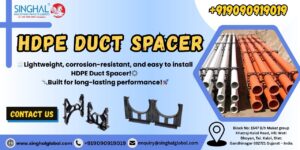You may have seen neat bundles in trenches of conduits if you’ve walked by a power plant under construction or a telecom project. It looks like a mess of pipes at first. If you look closer, you will see that there are small plastic cages or brackets that hold the pipes in place. HDPE duct spacers are the unsung heroes of underground utility ducts. These tiny components make a huge difference to their performance and durability. This article will explain everything you need: the purpose of HDPE duct spacers, their different types, how to install them, and where to find a quality supplier. I will also share my personal observations and experiences from various field projects. Duct systems are much more interesting than people think.
Why HDPE Duct Spacing Matters
Imagine pouring a bundle straight into the trench, without any spacers. When the concrete surrounding them was poured, they would wobble, push against each other, and deform. Vibration, soil pressure, and moisture caused heavy maintenance over time. HDPE (High Density Polyethylene) duct spacers are designed for this exact reason.
In essence, duct spacers:
- Separate and align multiple conduits.
- Avoid duct kinking, crushing, or shifting when concrete is being encased.
- Maintain straight and even channels to aid in airflow, cable pulling, and preventing snags.
- Reduce cable wear and tear, thereby reducing maintenance costs.
I recall speaking to a contractor who expressed frustration over repeated cable damage on a telecom line. It turned out that the ducts were laid without spacers over a decade earlier. The duct banks were much more durable and needed less work after they were reinstalled using HDPE duct spacers. This is one of those small investments that will save you a lot in the end.
Uses of HDPE Duct Spacers
Simply put, duct spacers perform two functions: they maintain spacing and carry loads. But let’s go a little deeper:
- Alignment is a guarantee: Ducts that are not aligned will bend in an awkward way, making it difficult to pull cables. Spacers help create a neat matrix.
- Load distribution: Because concrete is poured all around the setup, the spacers will distribute the load evenly over the conduits.
- Improvement of durability: They separate the ducts, which reduces friction, heat buildup and ultimately fatigue of the material.
- Simple maintenance: During the replacement of cables, the pulling is oriented by spacers and structured ducts. This simplifies it and it is painless.
They resemble the egg carton separators. They also make sure that weak elements (in this case, conduits) do not strike each other and break when pressurized.
Types of HDPE Duct Spacers
HDPE duct spacers are available in different types. There is no “one-size-fits-all” solution, but most manufacturers create duct spacers that are tailored to different ducting requirements. Broadly, you’ll find:
- Snap-in spacers: Quick and easy to install, without the need for extra tools. Mostly used on standard duct banks. They are best for projects that require high loads or concrete reinforcement, as they lock together tightly.
- Custom-size spacers: Spacers in unusual sizes are also ordered, usually with mixed conduit sizes. The original distinction between the base spacers and the intermediate spacers is that the former creates the initial layer of the trench at the base and the latter layers on top of the already created ones.
- Real life project: When engineers were working on a data center project in Ahmedabad, conduits of between 100mm and 150mm were ordered. The standard snap-in spacer was not enough. A Duct spacer manufacturer designed a set of customized duct spacers that fit both large and small ducts neatly in one trench.
Installing HDPE Duct Spacers
It may seem easy to install duct spacers, but this requires precision. Cable pulling can be a nightmare if the cables are misaligned even slightly. What happens on site?
- Trench preparation: Prepare the trench by digging it to the desired depth and ensuring that the base is clean, compacted, and flat.
- Placement of base spacers: The HDPE duct spacers are placed at exact intervals (usually between 1.5 and 2 meters).
- Concrete: After everything has been secured, concrete is poured around the entire setup to secure it.
Don’t rush through the alignment process. The majority of mistakes occur here. A minor tilt can become a major bottleneck when pulling a fiber optic cable.
Market Trends: Suppliers and Price
We’ll talk about money, because everyone wants to know. Duct spacer prices vary depending on the design, quality of material, and customization. They are cost-effective for bulk orders but more expensive if you want a customized layout. Compare that to the cost of repairing damaged ducts. It’s a clear winner.
Gujarat, in particular, is becoming an important hub for the manufacture of duct spacers. Duct spacer suppliers in Ahmedabad are now exporting to other countries, and their high quality has attracted international attention. Local players are now gaining market share from imported versions.
When you are working on a large-scale project, it is often more cost-effective to partner directly with a duct spacing manufacturer than to purchase them at retail.
Real-life Application Examples
Telecom Corridors: In Delhi, the backbone of a telecom network was built using HDPE spacers. This ensured that high-density fibre pipes would not collapse under the city’s traffic load. The result? Maintenance is now cheaper and faster when ISPs add new capacity.
Power Projects: An engineer from Chennai said that pulling HT cables before the adoption of spacers was like a tug-of-war. Cable pulls were smoother with spacers and required fewer workers.
Metro Rail Lines: High-rise conduit banks in Mumbai Metro were stabilized using interlocking HDPE spacers to ensure vibration resistance from adjacent tunneling did not misalign the ducts.
These tales demonstrate that small plastic spacers that even might appear insignificant initially could prove a useful device in the long run.
Conclusion
HDPE duct spacers may seem small, but they are essential to the underground operation of all our advanced cables and conduits. Spacers are worth a look, whether you’re planning your next construction project or simply curious about the latest technology. Sometimes the “invisible parts” of an infrastructure project hold it all together.
Frequently Asked Questions (FAQs)
Q1. Are HDPE duct spacers resistant to UV and chemicals?
Yes, HDPE spacers have been designed to be highly resistant against UV rays as well as most industrial chemicals. They are therefore a good choice for both exposed and buried duct systems.
Q2. Many suppliers offer customizable or adjustable options.
Always confirm your measurements before ordering.
Q3. Can both rigid PVC/steel and flexible HDPE conduits be used?
Absolutely. Their versatility is their greatest strength.
Q4. Can I order customized duct spacer layouts?
A large number of suppliers do provide custom design especially in large projects where the trench requirements are unusual. This will have to be discussed with the duct spacer manufacturer.
Q5. Who are the largest manufacturers of HDPE duct spacers?
While many global companies are at the forefront of this industry, India’s biggest players in the industry are located in Gujarat. Duct spacer suppliers in Ahmedabad have gained recognition for their affordable and export-quality products.









